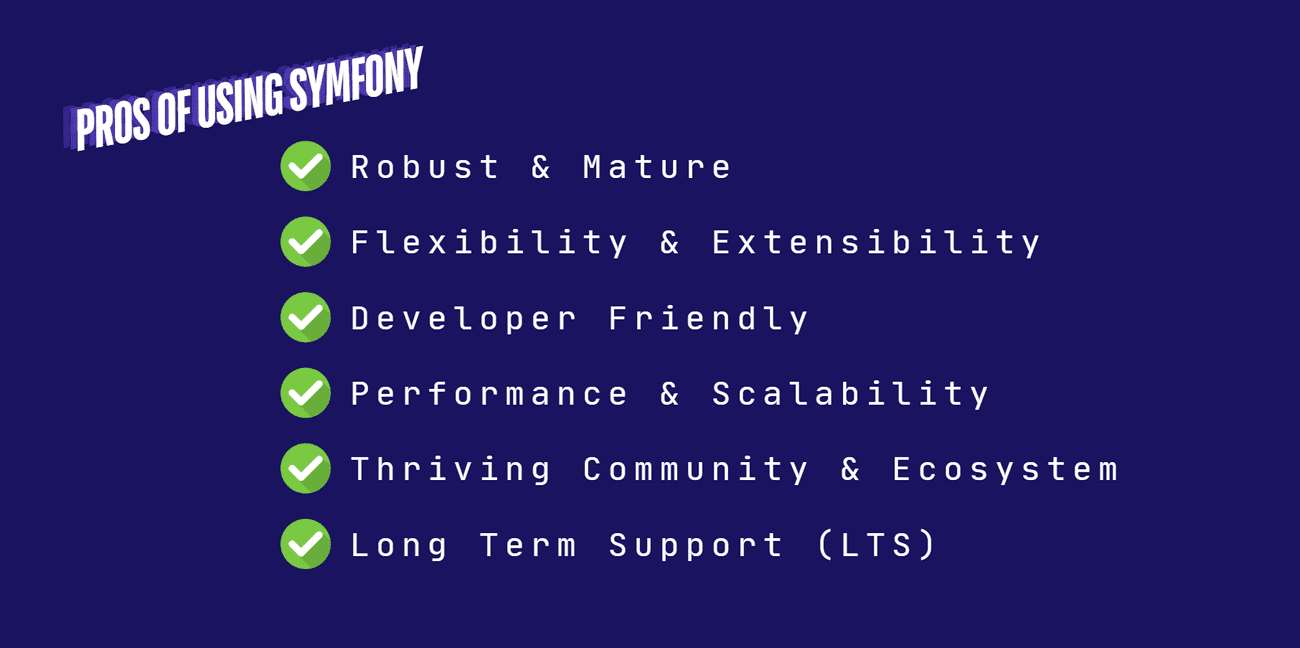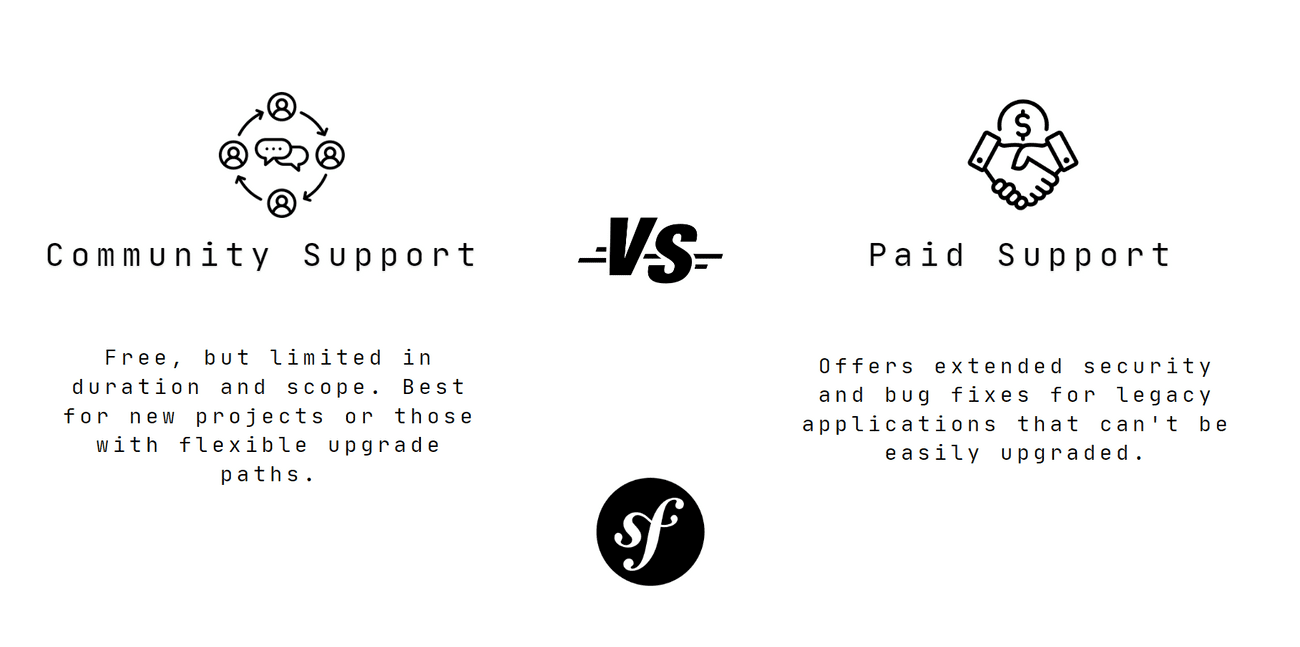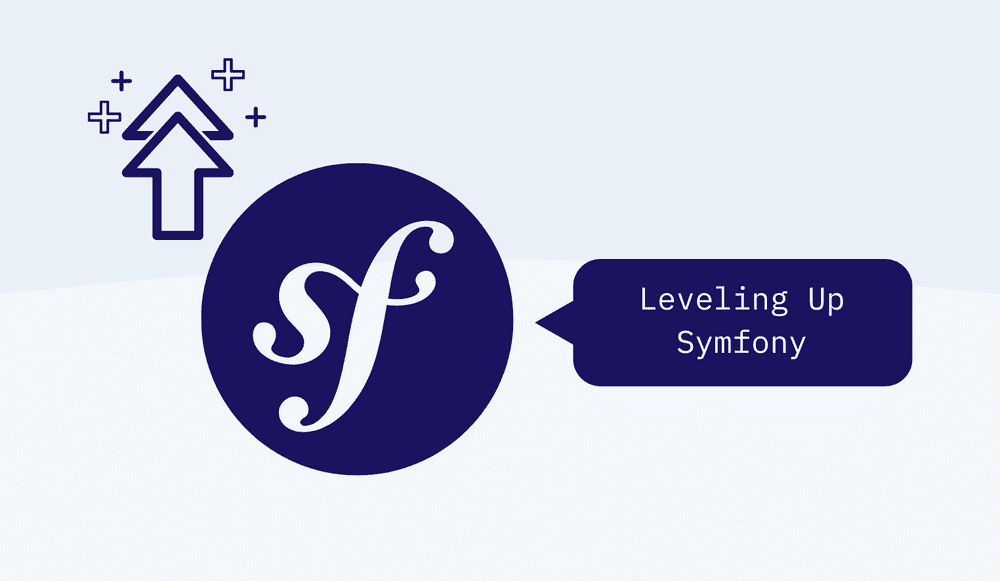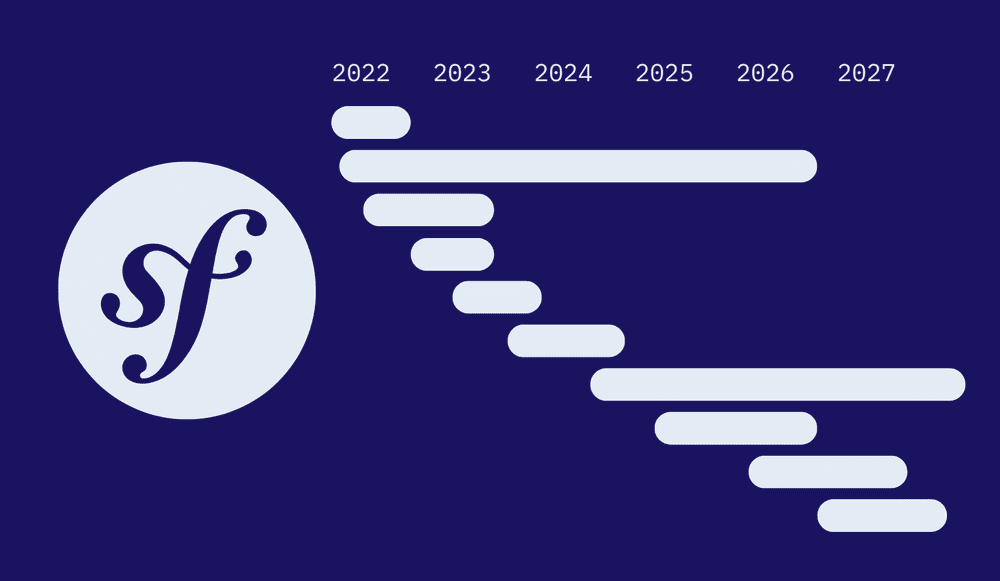Why is the Symfony LTS version a perfect choice for your web application?
In a recent post, we explored whether PHP is still relevant in 2024, especially considering its evolving versions and pragmatic tools. One key takeaway was that while PHP might be less popular overall, it remains a top choice for web application backends. PHP was designed to excel in this domain and continues to deliver. There's no reason to avoid choosing it for your next project.
A significant factor behind PHP's strength lies in two mature frameworks: Laravel and Symfony. Today, we'll dive deeper into Symfony, specifically its Long Term Support (LTS) version, and explain why it's an ideal foundation for your SaaS product or any web application. With Symfony LTS, you can build an app that will run smoothly for years with minimal maintenance.
Meet Symfony framework
Symfony has been a reliable presence in the PHP world since 2005, and it's not showing any signs of slowing down as it approaches its 20th anniversary. It's earned its place as a mature and respected framework, not by chance, but through a combination of solid design and a feature set that caters to a wide range of projects. Developers building everything from personal websites to large-scale enterprise applications have put their trust in Symfony, making it a true workhorse in the PHP ecosystem.
Let's delve into the technical underpinnings that make Symfony a standout choice among PHP frameworks.
1. Reputation and Community
Symfony's widespread adoption isn't just about its age. It is recognized as one of the best PHP frameworks; its vast and active community of developers contributes to its codebase, documentation, and ecosystem of reusable bundles.
The open-source framework thrives on collaboration, ensuring it accesses knowledge, troubleshooting resources, and a constant stream of improvements. Its reputation as a reliable and pragmatic tool attracts skilled developers who actively participate in shaping Symfony's future as a full-stack framework.
2. Flexibility Through Decoupled Components
Symfony's modular architecture, adhering to the Dependency Inversion Principle, empowers developers with granular control over their projects. This flexibility is key to its recognition as one of the best PHP frameworks. Components like the HttpFoundation for handling requests and responses, Routing for URL management, and DependencyInjection (a design pattern that promotes loose coupling and testability) can be individually utilized or replaced by other frameworks or libraries, tailoring the framework to specific needs. Whether you're building a traditional web application or a full-stack application with a JavaScript frontend, Symfony's modularity allows for seamless integration and customization.
3. Innovation Driven by PHP Standards
Symfony consistently pushes the boundaries of PHP innovation by embracing and often pioneering PHP Standards Recommendations (PSRs). This commitment ensures interoperability with vast libraries and components within the broader PHP ecosystem and fosters adherence to industry best practices. The active involvement of the Symfony community in numerous open-source projects further fuels innovation and problem-solving.
For example, Symfony's adoption of PSR-7 for HTTP message interfaces and PSR-11 for dependency injection containers guarantees seamless integration with other PSR-compliant libraries, making building modular and scalable applications easier. It is particularly beneficial for full-stack frameworks, where integrating different technologies seamlessly is crucial for a smooth development experience. Symfony's dedication to standards and its problem-solving community ensures that your application remains adaptable and can leverage the latest advancements in the PHP ecosystem.
4. Stability Through Testing and Standards
Symfony's emphasis on testing is a cornerstone of its stability. A robust test suite paired with seamless integration with PHPUnit, a popular PHP testing framework, ensures that each Symfony version and its components are rigorously validated. This focus on testing is evident in the core framework and extends to the vast ecosystem of open-source projects and bundles built upon Symfony.
Furthermore, Symfony's adherence to established standards, such as PSR-12 for coding style and PSR-4 for autoloading, fosters a predictable and maintainable codebase. The core team embraces this adherence to standards, which is actively promoted and practiced by the extensive community of Symfony users and contributors. This collective commitment to code quality and consistency ensures that Symfony remains a reliable and pragmatic tool for building complex applications.
5. Interoperability and Extensibility
What makes Symfony a favorite among developers? Its ability to play well with others. It effortlessly teams up with popular PHP tools you might already be using, like Doctrine for database tasks, Twig for designing web pages, and Symfony Mailer for sending emails.
If you need a head start on specific features, Symfony's got your back with its huge collection of ready-made solutions called bundles. These cover everything from user logins to building APIs, saving you tons of time and effort. Symfony's neat and tidy structure makes it a breeze to add these bundles to your project, giving you the freedom to build exactly what you need.
6. Permanence as a Guiding Principle
Symfony is all about building things that last. It's designed to be upgraded smoothly, even when big changes come along, so you don't have to worry about your app breaking. This is super important for complex projects that need regular updates.
The framework also makes a point of writing code that's easy to understand and work with, thanks to its well-organized structure and clear naming conventions. This makes life easier for developers, especially when working with different technologies at the same time.
What is long-term support, and why is it important?
In software development, "support" refers to a product's ongoing maintenance and improvement. It encompasses three key areas:
- New Features: These are enhancements that add functionality or improve existing features in the software.
- Bug Fixes: These correct errors or unexpected behaviour that could affect the software's performance or stability.
- Security Fixes: These address vulnerabilities in the software that malicious actors could exploit.
Software typically goes through two support phases:
- Standard Support: This is the initial period of active development, usually lasting 1-2 years. The software receives regular updates with new features, bug fixes, and security patches during this time.
- Extended Support (or Security Support): This phase focuses on security and stability. New features are generally not added, but the software continues receiving critical security updates for longer.
Long-Term Support (LTS) is a special type of extended support that lasts longer, often 3-5 years or more. While LTS versions may not have the latest features, they prioritize stability and security, making them a good choice for businesses that value reliability over cutting-edge functionality.
Using software that is no longer supported is risky for your project and users. Without updates, your web application becomes vulnerable to bugs, crashes, and security breaches. These issues can be costly and time-consuming to fix. Sometimes, you might need to rebuild your entire application using a newer, supported framework.
Even with LTS, it's important to apply updates proactively. Your developers should regularly update the software to ensure it has the latest bug fixes and security patches. It might require effort, but protecting your application and users' data is a small investment.
Paid vs community support?
Many modern technologies are open-source, meaning communities of developers rather than companies develop them. It makes them free and accessible to everyone, and often, support is readily available from the community at no cost.
However, in many open-source projects and scripts, community support has its limits. It typically lasts for a defined period, often 1-2 years, with some frameworks offering an additional period of security-only updates. After that, the community may move on to newer versions or projects, leaving older ones behind.
Paid support is another option for web development frameworks like Zend or Ruby on Rails. Companies specializing in these technologies offer extended support beyond the official end-of-life, ensuring your application continues functioning and receiving vital security updates and bug fixes.
This can be a lifeline if you're unable or unwilling to upgrade your technology due to time constraints, budget limitations, or other reasons. However, it's important to note that paid support comes at a cost and can be quite expensive compared to free community support.
Ultimately, the choice between paid and community support depends on your needs and priorities. Community support might be sufficient if cost is a significant factor, especially for newer projects and websites. However, if you're dealing with a mission-critical application that cannot be easily upgraded, paid support might be a worthwhile investment to ensure its long-term security and stability.
Symfony LTS - something you can rely on! For Free!
One of Symfony's standout features is its exceptional Long-Term Support (LTS). Unlike many web development frameworks that offer limited community support or charge for extended maintenance, Symfony LTS provides comprehensive support for an impressive duration – and it's entirely free.
Symfony's predictable roadmap and dedicated community ensure reliable, long-lasting support. Each fourth minor version is designated as an LTS release, receiving three years of updates and new features and an additional year of security upgrades. When you build your application on Symfony LTS, you're guaranteed at least four years of peace of mind, knowing that your framework, Symfony components, and custom modules will remain secure and up-to-date.
Symfony LTS vs. the Competition
How does this compare to other popular frameworks? Let's take a look at the free support durations for a few examples:
- Laravel (PHP): 1.5 years + 0.5 years security = 2 years total
- Django (Python): 1 year + 2 years security = 3 years total
- Node.js (JS): 30 months (2.5 years)
As you can see, Symfony LTS far surpasses these frameworks regarding free support duration. And remember, this is just for the backend component—frontend components and frontends like React or Angular often have even shorter support lifecycles, with new significant versions released every few months.
A Real-World Success Story for Complex Web Applications
To illustrate the value of Symfony LTS, let's share a brief anecdote. We were working on the development of several ERP systems for our client. These were complex back-office applications used by hundreds of employees. Due to funding constraints, our collaboration ended after the initial development.
We were pleasantly surprised to encounter our client three years later at a PHP conference. We learned that the applications ran smoothly, with no significant issues or bugs, even after three years of continuous use! This is a testament to the stability and reliability of Symfony LTS and Symfony components. Our client mentioned that with the LTS period ending, they were finally planning an upgrade – a testament to how long Symfony LTS can keep your application running smoothly without intervention.
This experience highlights the peace of mind that Symfony LTS provides. It's a framework you can build on with confidence, knowing that your application will remain stable and secure for years without incurring additional costs.
Why do we love Symfony PHP Framework?
In our previous story, the client mentioned that after three years of trouble-free operation, they might need to consider an upgrade. This brings us to another reason we love Symfony: its remarkable ease of upgrading.
We often joke that upgrading from one Symfony version to another usually takes two weeks, no matter the project size. While it's a bit of a running gag, there's the truth behind the humour. Our experience shows that Symfony upgrades are straightforward, even for large applications. This translates to a minimal investment of time and resources every few years—a significant advantage in the fast-paced world of software development.
At Accesto, we have long-term clients whose projects we've maintained for 7-8 years. This has given us firsthand experience with multiple Symfony upgrades. We don't wait for end-of-life to upgrade; we proactively update to take advantage of new features and performance improvements.
After 15 years in the industry, working with Symfony from its early versions to the present Symfony 7, we can confidently say that keeping Symfony applications up-to-date is remarkably easy compared to other technologies, especially on the front end. The rapid pace of front-end development can be a maintenance nightmare, with front-end versions appearing every few months. In contrast, Symfony's stability and upgrade process is a breath of fresh air.
In essence, Symfony offers long-term support and a smooth upgrade path. It is the best PHP framework for building complex web applications. This, combined with a predictable roadmap, constant development, a vibrant community, and even official certifications, makes Symfony a reliable, enjoyable, and future-proof choice for your web application.
Symfony's appeal extends far beyond its exceptional long-term support. Its ease of upgrades, predictable roadmap, constant development, vibrant community, and official certification program create an ecosystem that attracts talented developers and ensures code quality.
Why Choose Symfony LTS for Web Development?
While newer, JavaScript-based frameworks might seem tempting, Symfony LTS offers a proven track record of stability, reliability, and long-term maintainability. It's a framework that minimizes headaches and unexpected costs, allowing you to focus on building and growing your web application.
Symfony embodies the best of our 20 years of web development and complex web applications experience. It is a custom framework that combines stability and predictability with active development and a thriving ecosystem of contributors. It is why Accesto loves PHP frameworks like Symfony and confidently recommends them as the foundation for your next web application or product.
If you're looking for a framework that offers long-term support, a smooth upgrade path, and a vibrant developer community, Symfony LTS is the ideal choice. Ready to get started? Contact Accesto today to explore our Symfony development services.






